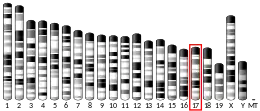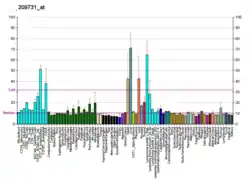NTHL1
Endonuclease III-like protein 1 is an enzyme that in humans is encoded by the NTHL1 gene.[5][6][7]
As reviewed by Li et al.,[8] NTHL1 is a bifunctional DNA glycosylase that has an associated beta-elimination activity. NTHL1 is usually involved in removing oxidative pyrimidine lesions through base excision repair. NTHL1 catalyses the first step in base excision repair. It cleaves the N-glycosylic bond between the damaged base and its associated sugar residue and then cleaves the phosphodiester bond 3' to the AP site,[9] leaving a 3'-unsaturated aldehyde after beta-elimination and a 5'-phosphate at the termini of the repair gap.[8]
Low expression of NTHL1 is associated with initiation and development of astrocytoma.[10] Low expression of NTHL1 is also found in follicular thyroid tumors.[11]
A germ line homozygous mutation in NTHL1 causes a cancer susceptibility syndrome similar to Lynch syndrome.[12][13]
References
- GRCh38: Ensembl release 89: ENSG00000065057 - Ensembl, May 2017
- GRCm38: Ensembl release 89: ENSMUSG00000041429 - Ensembl, May 2017
- "Human PubMed Reference:". National Center for Biotechnology Information, U.S. National Library of Medicine.
- "Mouse PubMed Reference:". National Center for Biotechnology Information, U.S. National Library of Medicine.
- Hilbert TP, Chaung W, Boorstein RJ, Cunningham RP, Teebor GW (Apr 1997). "Cloning and expression of the cDNA encoding the human homologue of the DNA repair enzyme, Escherichia coli endonuclease III". J Biol Chem. 272 (10): 6733–40. doi:10.1074/jbc.272.10.6733. PMID 9045706.
- Aspinwall R, Rothwell DG, Roldan-Arjona T, Anselmino C, Ward CJ, Cheadle JP, Sampson JR, Lindahl T, Harris PC, Hickson ID (Feb 1997). "Cloning and characterization of a functional human homolog of Escherichia coli endonuclease III". Proc Natl Acad Sci U S A. 94 (1): 109–14. doi:10.1073/pnas.94.1.109. PMC 19249. PMID 8990169.
- "Entrez Gene: NTHL1 nth endonuclease III-like 1 (E. coli)".
- Li J, Braganza A, Sobol RW (2013). "Base excision repair facilitates a functional relationship between Guanine oxidation and histone demethylation". Antioxid. Redox Signal. 18 (18): 2429–43. doi:10.1089/ars.2012.5107. PMC 3671628. PMID 23311711.
- Odell ID, Barbour JE, Murphy DL, Della-Maria JA, Sweasy JB, Tomkinson AE, Wallace SS, Pederson DS (2011). "Nucleosome disruption by DNA ligase III-XRCC1 promotes efficient base excision repair". Mol. Cell. Biol. 31 (22): 4623–32. doi:10.1128/MCB.05715-11. PMC 3209256. PMID 21930793.
- Jiang Z, Hu J, Li X, Jiang Y, Zhou W, Lu D (2006). "Expression analyses of 27 DNA repair genes in astrocytoma by TaqMan low-density array". Neurosci. Lett. 409 (2): 112–7. doi:10.1016/j.neulet.2006.09.038. PMID 17034947.
- Karger S, Krause K, Engelhardt C, Weidinger C, Gimm O, Dralle H, Sheu-Grabellus SY, Schmid KW, Fuhrer D (2012). "Distinct pattern of oxidative DNA damage and DNA repair in follicular thyroid tumours". J. Mol. Endocrinol. 48 (3): 193–202. doi:10.1530/JME-11-0119. PMID 22331172.
- Kuiper RP, Hoogerbrugge N (2015). "NTHL1 defines novel cancer syndrome". Oncotarget. 6 (33): 34069–70. doi:10.18632/oncotarget.5864. PMC 4741436. PMID 26431160.
- Weren RD, Ligtenberg MJ, Kets CM, de Voer RM, Verwiel ET, Spruijt L, van Zelst-Stams WA, Jongmans MC, Gilissen C, Hehir-Kwa JY, Hoischen A, Shendure J, Boyle EA, Kamping EJ, Nagtegaal ID, Tops BB, Nagengast FM, Geurts van Kessel A, van Krieken JH, Kuiper RP, Hoogerbrugge N (2015). "A germline homozygous mutation in the base-excision repair gene NTHL1 causes adenomatous polyposis and colorectal cancer". Nat. Genet. 47 (6): 668–71. doi:10.1038/ng.3287. PMID 25938944. S2CID 24075977.
Further reading
- Hilbert TP, Boorstein RJ, Kung HC, et al. (1996). "Purification of a mammalian homologue of Escherichia coli endonuclease III: identification of a bovine pyrimidine hydrate-thymine glycol DNAse/AP lyase by irreversible cross linking to a thymine glycol-containing oligoxynucleotide". Biochemistry. 35 (8): 2505–11. doi:10.1021/bi952516e. PMID 8611553.
- Ikeda S, Biswas T, Roy R, et al. (1998). "Purification and characterization of human NTH1, a homolog of Escherichia coli endonuclease III. Direct identification of Lys-212 as the active nucleophilic residue". J. Biol. Chem. 273 (34): 21585–93. doi:10.1074/jbc.273.34.21585. PMID 9705289.
- Sarker AH, Ikeda S, Nakano H, et al. (1999). "Cloning and characterization of a mouse homologue (mNthl1) of Escherichia coli endonuclease III". J. Mol. Biol. 282 (4): 761–74. doi:10.1006/jmbi.1998.2042. PMID 9743625.
- Imai K, Sarker AH, Akiyama K, et al. (1999). "Genomic structure and sequence of a human homologue (NTHL1/NTH1) of Escherichia coli endonuclease III with those of the adjacent parts of TSC2 and SLC9A3R2 genes". Gene. 222 (2): 287–95. doi:10.1016/S0378-1119(98)00485-5. PMID 9831664.
- Bessho T (1999). "Nucleotide excision repair 3' endonuclease XPG stimulates the activity of base excision repairenzyme thymine glycol DNA glycosylase". Nucleic Acids Res. 27 (4): 979–83. doi:10.1093/nar/27.4.979. PMC 148276. PMID 9927729.
- Luna L, Bjørås M, Hoff E, et al. (2000). "Cell-cycle regulation, intracellular sorting and induced overexpression of the human NTH1 DNA glycosylase involved in removal of formamidopyrimidine residues from DNA". Mutat. Res. 460 (2): 95–104. doi:10.1016/s0921-8777(00)00015-x. PMID 10882850.
- Matsumoto Y, Zhang QM, Takao M, et al. (2002). "Escherichia coli Nth and human hNTH1 DNA glycosylases are involved in removal of 8-oxoguanine from 8-oxoguanine/guanine mispairs in DNA". Nucleic Acids Res. 29 (9): 1975–81. doi:10.1093/nar/29.9.1975. PMC 37258. PMID 11328882.
- Miyabe I, Zhang QM, Kino K, et al. (2002). "Identification of 5-formyluracil DNA glycosylase activity of human hNTH1 protein". Nucleic Acids Res. 30 (15): 3443–8. doi:10.1093/nar/gkf460. PMC 137084. PMID 12140329.
- Liu X, Roy R (2002). "Truncation of amino-terminal tail stimulates activity of human endonuclease III (hNTH1)". J. Mol. Biol. 321 (2): 265–76. doi:10.1016/S0022-2836(02)00623-X. PMID 12144783.
- Strausberg RL, Feingold EA, Grouse LH, et al. (2003). "Generation and initial analysis of more than 15,000 full-length human and mouse cDNA sequences". Proc. Natl. Acad. Sci. U.S.A. 99 (26): 16899–903. doi:10.1073/pnas.242603899. PMC 139241. PMID 12477932.
- Marenstein DR, Chan MK, Altamirano A, et al. (2003). "Substrate specificity of human endonuclease III (hNTH1). Effect of human APE1 on hNTH1 activity". J. Biol. Chem. 278 (11): 9005–12. doi:10.1074/jbc.M212168200. PMID 12519758.
- Ikeda S, Kohmoto T, Tabata R, Seki Y (2003). "Differential intracellular localization of the human and mouse endonuclease III homologs and analysis of the sorting signals". DNA Repair (Amst.). 1 (10): 847–54. doi:10.1016/S1568-7864(02)00145-3. PMID 12531031.
- Liu X, Choudhury S, Roy R (2004). "In vitro and in vivo dimerization of human endonuclease III stimulates its activity". J. Biol. Chem. 278 (50): 50061–9. doi:10.1074/jbc.M309997200. PMID 14522981.
- Katafuchi A, Nakano T, Masaoka A, et al. (2004). "Differential specificity of human and Escherichia coli endonuclease III and VIII homologues for oxidative base lesions". J. Biol. Chem. 279 (14): 14464–71. doi:10.1074/jbc.M400393200. PMID 14734554.
- Wiederhold L, Leppard JB, Kedar P, et al. (2004). "AP endonuclease-independent DNA base excision repair in human cells". Mol. Cell. 15 (2): 209–20. doi:10.1016/j.molcel.2004.06.003. PMID 15260972.
- Oyama M, Wakasugi M, Hama T, et al. (2004). "Human NTH1 physically interacts with p53 and proliferating cell nuclear antigen". Biochem. Biophys. Res. Commun. 321 (1): 183–91. doi:10.1016/j.bbrc.2004.06.136. PMID 15358233.
- Gerhard DS, Wagner L, Feingold EA, et al. (2004). "The status, quality, and expansion of the NIH full-length cDNA project: the Mammalian Gene Collection (MGC)". Genome Res. 14 (10B): 2121–7. doi:10.1101/gr.2596504. PMC 528928. PMID 15489334.
- Zhang QM, Yonekura S, Takao M, et al. (2005). "DNA glycosylase activities for thymine residues oxidized in the methyl group are functions of the hNEIL1 and hNTH1 enzymes in human cells". DNA Repair (Amst.). 4 (1): 71–9. doi:10.1016/j.dnarep.2004.08.002. PMID 15533839.





